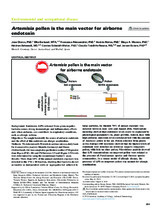Mostrar el registro sencillo del ítem
Artemisia pollen is the main vector for airborne endotoxin
| dc.contributor.author | Oteros, José | |
| dc.contributor.author | Bartusel, Elke | |
| dc.contributor.author | Alessandrini, Francesca | |
| dc.contributor.author | Núñez, Andrés | |
| dc.contributor.author | Moreno, Diego | |
| dc.contributor.author | Behrendt, Heidrun | |
| dc.contributor.author | Schmidt-Weber, Carsten | |
| dc.contributor.author | Traidl-Hoffmann, Claudia | |
| dc.contributor.author | Buters, Jeroen | |
| dc.date.accessioned | 2024-02-08T21:25:47Z | |
| dc.date.available | 2024-02-08T21:25:47Z | |
| dc.date.issued | 2018 | |
| dc.identifier.issn | 0091-6749 | |
| dc.identifier.uri | http://hdl.handle.net/10396/27339 | |
| dc.description.abstract | Background: Endotoxin (LPS) released from gram-negative bacteria causes strong immunologic and inflammatory effects and, when airborne, can contribute to respiratory conditions, such as allergic asthma. Objectives: We sought to identify the source of airborne endotoxin and the effect of this endotoxin on allergic sensitization. Methods: We determined LPS levels in outdoor air on a daily basis for 4 consecutive years in Munich (Germany) and Davos (Switzerland). Air was sampled as particulate matter (PM) greater than 10 mm (PM > 10) and PM between 2.5 and 10 mm. LPS levels were determined by using the recombinant Factor C assay. Results: More than 60% of the annual endotoxin exposure was detected in the PM > 10 fraction, showing that bacteria do not aerosolize as independent units or aggregates but adhered to large particles. In Munich 70% of annual exposure was detected between June 12th and August 28th. Multivariate modeling showed that endotoxin levels could be explained by phenological parameters (ie, plant growth). Indeed, days with high airborne endotoxin levels correlated well with the amount of Artemisia pollen in the air. Pollen collected from plants across Europe (100 locations) showed that the highest levels of endotoxin were detected on Artemisia vulgaris (mugwort) pollen, with little on other pollen. Microbiome analysis showed that LPS concentrations on mugwort pollen were related to the presence of Pseudomonas species and Pantoea species communities. In a mouse model of allergic disease, the presence of LPS on mugwort pollen was needed for allergic sensitization. | es_ES |
| dc.format.mimetype | application/pdf | es_ES |
| dc.language.iso | eng | es_ES |
| dc.publisher | American Academy of Allergy, Asthma & Immunology | es_ES |
| dc.rights | https://creativecommons.org/licenses/by-nc-nd/4.0/ | es_ES |
| dc.source | Oteros, J., Bartusel, E., Alessandrini, F., Nunez, A., Moreno, D. A., Behrendt, H., Schmidt-Weber, C., Traidl-Hoffmann, C., & Buters, J. (2019). Artemisia pollen is the main vector for airborne endotoxin. Journal of Allergy and Clinical Immunology, 143(1), 369-377. http://dx.doi.org/10.1016/j.jaci.2018.05.040 | es_ES |
| dc.subject | Endotoxin | es_ES |
| dc.subject | Ambient | es_ES |
| dc.subject | Bacteria | es_ES |
| dc.subject | Pollen | es_ES |
| dc.subject | Gram-negative | es_ES |
| dc.subject | Recombinant Factor c | es_ES |
| dc.subject | Davos | es_ES |
| dc.subject | Munich | es_ES |
| dc.subject | Artemisia species | es_ES |
| dc.subject | Microbiome | es_ES |
| dc.subject | Mouse model | es_ES |
| dc.subject | Allergy | es_ES |
| dc.subject | LPS | es_ES |
| dc.subject | Source | es_ES |
| dc.subject | PM10 | es_ES |
| dc.subject | PM2.5 | es_ES |
| dc.title | Artemisia pollen is the main vector for airborne endotoxin | es_ES |
| dc.type | info:eu-repo/semantics/article | es_ES |
| dc.relation.publisherversion | http://dx.doi.org/10.1016/j.jaci.2018.05.040 | es_ES |
| dc.rights.accessRights | info:eu-repo/semantics/openAccess | es_ES |

